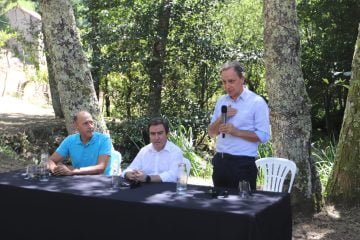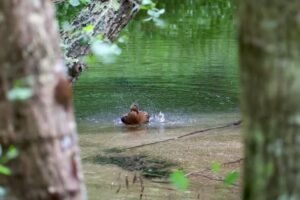The municipality’s main water lines, the Ovil and Teixeira rivers, are strategic assets that the Baião Council is reclassifying, in line with the environmental policies followed by the municipality, namely the commitment to sustainability – Baião was the first portuguese municipality to receive the certification as a Sustainable Tourist Destination – and in valuing heritage and natural resources.
In this context, the Requalification Strategy for the Main Water Lines of the Municipality was presented in the Leisure Area of Medim, Outoriça, on the 11th of August, followed by the signing ceremony of the consignment order for the Requalification and Enhancement work of the Ovil River – Upstream Section.
“This is another step towards achieving our goals. Yet another project, which I’ve known since 1998, which seemed impossible, but which we are implementing. It is yet another example that it is possible to overcome obstacles – and we had them, for example, with regard to the terrain along the route – but we managed and, therefore, this is another very important day for Baião, for all of us, which makes me very satisfied”, underlined the Mayor of Baião, Paulo Pereira, at the ceremony.
The mayor, after drawing a timeline from the launch of the idea to this stage of the process, recalled the challenges that still arise, namely negotiations with the owners of marginal land on the Ovil river section, still in Campelo, in Gôve and in Ancede, and the 18 kilometers of the Teixeira river.
“FOR GOOD PROJECTS THERE WILL BE NO LACK OF SUPPORT”
The Vice-President of the Portuguese Agency for the Environment (APA), José Pimenta Machado, showed his appreciation for the work that the Municipality of Baião has been developing, praising the “persistence” of the Mayor, who “does not give up on projects in which he believes and which he considers important for the population and for the municipality”, and, referring to the next community framework – PT 2030, guaranteed that “for good projects, there will be no lack of support”.
The author of the Watercourse Rehabilitation and Enhancement Projects, Pedro Teiga, PhD in environmental engineering and specialist in the rehabilitation of rivers and streams, presented the studies in context, highlighting the richness of the existing fauna and flora – to be preserved and to reinforce – the importance of involving riverside landowners and raising awareness of the benefits of the entire project, among other benefits for the territory.
River Ovil – The route
The global route under rehabilitation is around 16 km long, from the source, next to the Aboboreira and Matos mountains, to Foz on the Douro river.
It is characterized by enormous cultural and environmental potential, as the river passes through the oak forest of Reixela (autochthonous oak forest), prehistoric monuments, along with ancient rock castles (Ovil and Penalva), monuments of the Romanesque/Medieval Route (bridge de Esmoriz and Monastery of Ancede), Roman path, a possible geosite, numerous mills and levadas, and various agricultural mosaics.
THE PROJECT
The project aims to rehabilitate and enhance the river, in a sustainable development strategy, using natural engineering techniques. This area of engineering is concerned with enhancing watercourses and stabilizing slopes through the use of living material, combined with inert structures such as wood or stone.
The objective is to create an “ecological corridor”, which is a place to enjoy nature, a tourist attraction (controlled, given the need to preserve the environmental balance), awareness and environmental education.
In all its extension, the intervention in the riverside corridor foresees the carrying out of work to consolidate the banks, cut and clean the vegetation, contain exotic and invasive vegetation and remove debris and correct irregularities.
Old communal and existing service roads will be improved, through the application of resistant pavements, with the installation of urban furniture in wood and the construction of ditches for the routing of water in places where this need is verified.
The project phases
– Foz Section with an approximate length of 2.5 km between Ponte Nova (Ancede) and Foz do Ovil (Ribadouro), a project that is in the final stages of execution and which was awarded for 157 thousand euros, financed by the Portuguese Agency for Environment and by the Municipality of Baião;
– Upstream Section also with a length of about 2.5 km, from the Leisure Area of Medim – Outoreça (Ovil) to the bridge of Rua de Covelo (Campelo), contract awarded on 07/25/2023 for 231,937, 00 euros, now consigned.
GEOSITE
In the section next to Poço Negro, a possible geosite was also identified – a place of particular interest for the study of geology, remarkable from a scientific point of view, due to the uniqueness of its geological formations or the mineral nature of the subsoil.
A preliminary survey has already been carried out on site with a team from the Geology area, from UTAD, led by Artur Sá, who identified its potential: an extensive area in which the river disappears between the rocks, in a geological phenomenon that would have occurred successive collapse of granite blocks that will have formed an underground channel with several caves.
This site appears to be a unique phenomenon in the region, which deserves to be studied in more detail, in order to understand its formation process, identification of fauna and flora and scientific and tourist potential, with a view to its future classification.
















